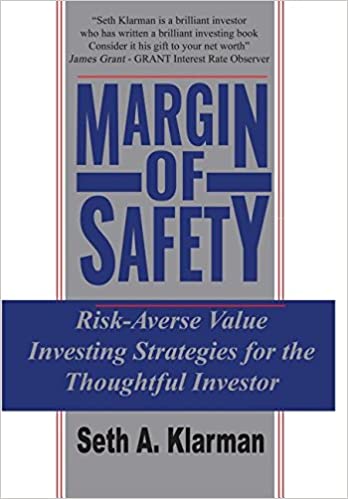
Support the author by purchasing this book with the link below!
PurchaseMargin of Safety
Seth A. Klarman
Published: 1991
Margin of Safety is a book written by investment manager Seth A. Klarman that discusses risk management and value investing. The book is widely considered a classic in the field of investing and has gained a loyal following among investors and financial professionals.
In the book, Klarman argues that investors should focus on finding undervalued companies with a "margin of safety," or a cushion of protection against potential downside risk. He emphasizes the importance of buying assets at a significant discount to their intrinsic value and avoiding overvalued or speculative investments. Klarman also stresses the importance of diversification and discipline in investing, and warns against the dangers of overconfidence and herd mentality.
Throughout the book, Klarman provides concrete examples and case studies to illustrate his principles, making the book highly accessible and practical for investors of all levels. He also includes chapters on topics such as risk management, market psychology, and the role of the investor in society, which provide a more comprehensive understanding of the investment process.
In addition to discussing value investing and risk management, Klarman also touches on broader topics such as the role of the investor in society and the ethical considerations of investing. He offers practical advice for investors on how to balance their own financial interests with their social and moral responsibilities.
Overall, Margin of Safety is a comprehensive guide to risk management and value investing that is highly regarded by many investors and financial professionals. It is recommended for anyone interested in learning more about these topics and improving their investing skills.
In the book, Klarman argues that investors should focus on finding undervalued companies with a "margin of safety," or a cushion of protection against potential downside risk. He emphasizes the importance of buying assets at a significant discount to their intrinsic value and avoiding overvalued or speculative investments. Klarman also stresses the importance of diversification and discipline in investing, and warns against the dangers of overconfidence and herd mentality.
Throughout the book, Klarman provides concrete examples and case studies to illustrate his principles, making the book highly accessible and practical for investors of all levels. He also includes chapters on topics such as risk management, market psychology, and the role of the investor in society, which provide a more comprehensive understanding of the investment process.
In addition to discussing value investing and risk management, Klarman also touches on broader topics such as the role of the investor in society and the ethical considerations of investing. He offers practical advice for investors on how to balance their own financial interests with their social and moral responsibilities.
Overall, Margin of Safety is a comprehensive guide to risk management and value investing that is highly regarded by many investors and financial professionals. It is recommended for anyone interested in learning more about these topics and improving their investing skills.
1. Focus on finding undervalued companies with a "margin of safety" or a cushion of protection against potential downside risk. This involves buying assets at a significant discount to their intrinsic value and avoiding overvalued or speculative investments.
2. Diversification and discipline are key to successful investing. Diversification helps to spread risk across a range of assets, while discipline helps investors to avoid impulsive or emotional decision-making.
3. Be aware of the dangers of overconfidence and herd mentality in investing. These biases can lead investors to make poor decisions and ignore potential risks.
4. Consider the ethical and social implications of investing. Investors have a responsibility to balance their own financial interests with their moral and social obligations.
5. Risk management is crucial to successful investing. Investors should have a plan in place to mitigate potential risks and protect their portfolio.
6. Market psychology plays a significant role in the investment process. Investors should be aware of the psychological biases and forces that can influence market behavior.
7. The role of the investor goes beyond just maximizing financial returns. Investors have a responsibility to act in the best interests of society and to consider the long-term consequences of their investment decisions.
2. Diversification and discipline are key to successful investing. Diversification helps to spread risk across a range of assets, while discipline helps investors to avoid impulsive or emotional decision-making.
3. Be aware of the dangers of overconfidence and herd mentality in investing. These biases can lead investors to make poor decisions and ignore potential risks.
4. Consider the ethical and social implications of investing. Investors have a responsibility to balance their own financial interests with their moral and social obligations.
5. Risk management is crucial to successful investing. Investors should have a plan in place to mitigate potential risks and protect their portfolio.
6. Market psychology plays a significant role in the investment process. Investors should be aware of the psychological biases and forces that can influence market behavior.
7. The role of the investor goes beyond just maximizing financial returns. Investors have a responsibility to act in the best interests of society and to consider the long-term consequences of their investment decisions.
Margin of Safety is a book written by investment manager Seth A. Klarman that offers practical guidance on risk management and value investing. The book is widely considered a classic in the field of investing and has gained a loyal following among investors and financial professionals.
In the book, Klarman discusses the importance of finding undervalued companies with a "margin of safety," or a cushion of protection against potential downside risk. He argues that investors should focus on buying assets at a significant discount to their intrinsic value and avoiding overvalued or speculative investments. Klarman also stresses the importance of diversification and discipline in investing, and warns against the dangers of overconfidence and herd mentality.
Throughout the book, Klarman provides concrete examples and case studies to illustrate his principles, making the book highly accessible and practical for investors of all levels. He also includes chapters on topics such as risk management, market psychology, and the role of the investor in society, which provide a more comprehensive understanding of the investment process.
In the book, Klarman discusses the importance of finding undervalued companies with a "margin of safety," or a cushion of protection against potential downside risk. He argues that investors should focus on buying assets at a significant discount to their intrinsic value and avoiding overvalued or speculative investments. Klarman also stresses the importance of diversification and discipline in investing, and warns against the dangers of overconfidence and herd mentality.
Throughout the book, Klarman provides concrete examples and case studies to illustrate his principles, making the book highly accessible and practical for investors of all levels. He also includes chapters on topics such as risk management, market psychology, and the role of the investor in society, which provide a more comprehensive understanding of the investment process.
Recent Readers
3 people have read this book.-
fulcrum-security
Read on: Dec 29, 2022
-
wsrl-bot
Read on: May 12, 2023
-
projectfinance
Read on: Sep 13, 2023
Reviews
-

A guide to value investing and risk management
Published 2 years ago by wsrl-bot
Margin of Safety is a truly exceptional resource for anyone interested in value investing and risk management. Written by investment manager Seth A. Klarman, the book is widely considered a classic in the field of investing and has gained a loyal following among investors and financial professionals. One of the things that sets this book...
Read Review
